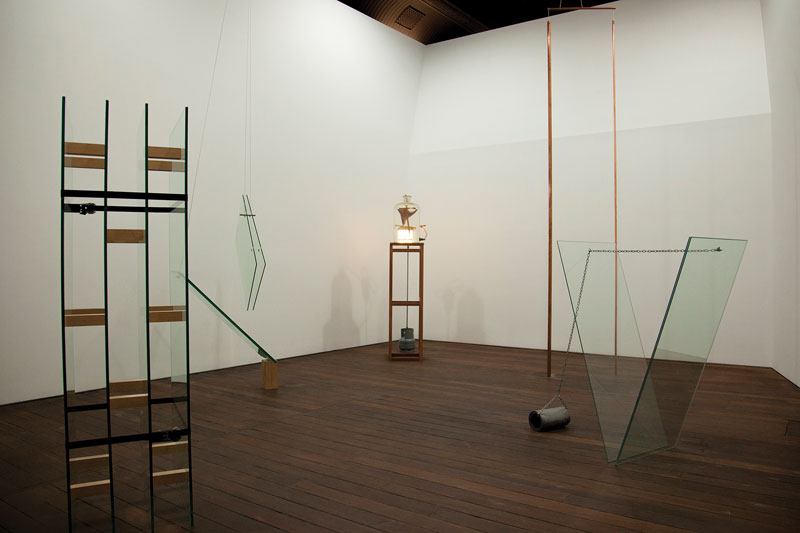
Hold your horses, this is no ordinary Pioneer Village. No rustic buildings, no bucking broncos or dusty cart relics. Despite the promo image featuring a galloping stallion, this exhibition does not hinge on its promising title to take you on a nostalgic journey. There is none of the usual yahoo dust and survivor machismo associated with such a context; it has a frontier reasoning all of its own, it is a pioneer village churned through the logic of contemporary art.
Local Perth artist Alistair Rowe has distilled the idea of the Pioneer Village, purified and sapped it of known qualities. The reference is drawn from a now defunct history park not far from Rowe’s home in the Perth hills, Pioneer World. This recreated village once ran a thriving tourist trade; taking visitors back in time to age-old traditions and watered down versions of the prospecting life of early settlers living on the edge of the unknown. Today it is a quaint, but skeletal version of its former self.
From this relic Rowe’s exhibition carries forward the idea of obsolescence, specifically at the level of the mechanisms and contraptions, like gas burners and waterwheels, which defined life on the dusty frontier. It also focuses on the idea of the fragility of the past and its susceptibility to manipulation in light of the fact that today the Pioneer Village, any Pioneer Village, is generally understood through a series of clichés perpetuated through theme-park simulacra. The harsh realities of setting up livelihoods and building new towns on the fringes are reduced to such symbols as damper, horse and cart tours, colonial architecture and celebratory claims of ‘‘authentic recreation’’.
In distinction to this, Rowe’s exhibition is a series of new minimal sculptural works that take form as precarious propositions made using industrial materials, including copper, wood, glass and steel. They delicately balance, counterbalance, hang, spin, bubble and generate subtle optical effects. This makes them compelling in a mesmeric, puzzling and poised way. Planar wedges of glass play with the viewer’s perception and futile contraptions puzzle the mind. The piece titled Tourmaline, for example, consists of two copper tubes hanging side-by side to form a quasi-doorway. They very gently spin and on the odd occasion they will hit a raised nail in the floorboards, this will resound in an almost imperceptible ting throughout the tiny gallery space, creating a moment of wonder that is surprisingly delightful, despite the risk of being confused with a mobile phone. Another work, A Minor Occurrence, features a gas lamp used to heat up copper tubing that winds itself into a glass beacon of water. This process generates bubbles that float up through the liquid. Both works are reminiscent of age-old contraptions without any degree of functionality; they are utterly non-utilitarian and as banal as the revived heritage traditions of the pioneer village for touristic ends.
In addition to its perceptive commentary on the sad fate of pioneer heritage, the works in this show also resonate with the unique architecture of the Moana site. The Moana Chambers are located in the Perth CBD and, like a Pioneer Village, they too maintain a complex heritage. Opened in 1908 as a café, the Chambers have since been adopted by a range of different business ventures. Before the current uptake of the first floor by creative professionals, the space was unoccupied for a period of fourteen years. It was reinvigorated through the initiative of a group called Spacemarket, whose mission it is to source and take action to revive disused spaces within the city. Today it is a burgeoning mixed-use creative space. The gallery/project space shares the floor with a café, studios used by local artists and architects and a fledgling artist’s residency program currently poised to pick up speed and extend to the second floor.
The Moana Project Space is a small distorted white cube which functions as an artist-run-initiative headed up by directors Kate Mullen and Dale Buckley. Currently the exhibitions run on an invitational basis, supporting emerging, established, local, national and international artists. Thus far the curatorial vision has veered toward shows of a minimal, conceptual and site-specific nature, with future orientation primed towards the greater inclusion of new media and ongoing experimental explorations of the space. Rowe’s exhibition fits snugly within this vision, poised as it is between a conceptual consideration of an iconic historical phenomenon and occupying Moana in such a way as to draw attention to the spatial conditions of this classic-made-contemporary architecture.












